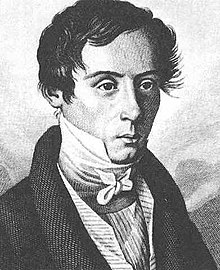Augustin Jean Fresnel
Augustin Jean Fresnel [ oɡysˈtɛ̃ ʒɑ̃ fʀɛˈnɛl ] (born May 10, 1788 in Broglie ( Département Eure ), † July 14, 1827 in Ville-d'Avray near Paris ) was a French physicist and engineer who was instrumental in establishing the wave theory of light and contributed to the look . He studied the behavior of light both theoretically and experimentally.
Life
Fresnel was the son of an architect and suffered from a severe learning disability as a child, so that he could not read at the age of nine. At thirteen he entered the École Centrale in Caen , and at sixteen and a half in the École polytechnique , which he graduated with honors as an engineer. Then he went to the École nationale des ponts et chaussées . He worked as an engineer for the departments of Vendée , Drôme and Ille-et-Vilaine. But since he had supported the Bourbons , he lost his job in 1814 when Napoleon came back to power. During the second restoration of the monarchy, he was given a post as an engineer in Paris , where he spent much of the rest of his life.
His research in optics , which he continued until his death, appears to have begun around 1814 when he was preparing an article on the aberration of light that was not published. In 1818 he wrote an article on diffraction , for which he received the prize of the Académie des sciences in Paris the following year (see also Poisson-Fleck ). In 1823 he was unanimously elected a member of the academy. In 1825 he was elected as a Foreign Member of the Royal Society in London , from which he was awarded the Rumford Medal in 1824 . In 1819 he was appointed secretary of the commission for lighthouses , for which he constructed Fresnel lenses for the first time to replace the mirrors previously used. He died of tuberculosis near Paris .
The wave theory of light, first demonstrated experimentally by Thomas Young , was expanded to a large class of optical phenomena and was permanently established through his brilliant discoveries and mathematical derivations. By using two flat metal mirrors that were arranged at an angle of almost 180 ° to each other, he avoided the diffraction that occurred in the experiment of Francesco Maria Grimaldi (1618–1663) through the use of diaphragms for light transmission . This enabled him to take into account the interference phenomena in a convincing manner in accordance with the wave theory. In addition to this experiment, Fresnel is also known for his interference experiment with the biprism .
With François Arago he studied the laws of interference of polarized rays. They summarized some of their results in 4 statements, the Fresnel-Arago laws . It generated circularly polarized light with the help of a glass rhombus , known as a Fresnel rhombus , with obtuse angles of 126 ° and acute angles of 54 °. His work on optics received little public recognition during his lifetime, and many of his articles were not printed by the Académie des Sciences until years after his death. But, as he wrote to Young in 1824, "the sensitivity or vanity that is called the love of fame" was dulled in him. "All the compliments I received from Arago, Laplace and Biot never gave me as much pleasure as discovering the theoretical truth, or confirming a calculation through experiment."
In 1969 the French suggested naming a unit of frequency (one terahertz) Fresnel in his honor , but this was never implemented. The Fresnel number , which is a measure of the strength of the diffraction at a diaphragm, is named after him.
Fresnel is immortalized among the 72 names on the Eiffel Tower .
Deonyms
Fresnel's name found its way into the following terms ( deonyms ):
- The Fresnel integrals are special improper integrals .
- The Fresnel formulas deal with the reflectance of electromagnetic waves.
- Fresnel lenses can produce just as short focal lengths as conventional lenses with much less glass.
- The Fresnel zone plate can also be used for X-rays due to diffraction and interference.
- The Fresnel zone describes a spatial area between the transmitting and receiving antenna of a radio link.
- The Fresnel biprism experiment is an experimental setup for generating interference from light rays from a divergent light source.
- The Fresnel double mirror also generates interference-capable light beams from a divergent light source.
- In 1969 France proposed Fresnel as the unit for frequency.
- The asteroid (10111) Fresnel has been named after him since 1999
- The Rimae Fresnel on the Earth's moon is named after him.
- The Fresnel parallelepiped is an optical prism with which 45 ° linearly polarized light can be converted into circularly polarized light.
- The Fresnel entrainment coefficient was used to calculate the speed of light in moving media.
- The Fresnel number describes how strong the diffraction of a light beam at a diaphragm is.
Web links
- Literature by and about Augustin Jean Fresnel in the catalog of the German National Library
- Article by / about Augustin Jean Fresnel in the Polytechnisches Journal
Individual evidence
- ^ List of members since 1666: Letter F. Académie des sciences, accessed on November 16, 2019 (French).
- ↑ Moritz Ehlken and Nils Kröger: Fresnel'scher double mirror experiment. (PDF; 883 kB) (No longer available online.) March 2004, archived from the original on May 17, 2014 ; accessed on March 30, 2013 .
| personal data | |
|---|---|
| SURNAME | Fresnel, Augustin Jean |
| BRIEF DESCRIPTION | French physicist and engineer |
| DATE OF BIRTH | May 10, 1788 |
| PLACE OF BIRTH | Broglie |
| DATE OF DEATH | July 14, 1827 |
| Place of death | Ville-d'Avray |

